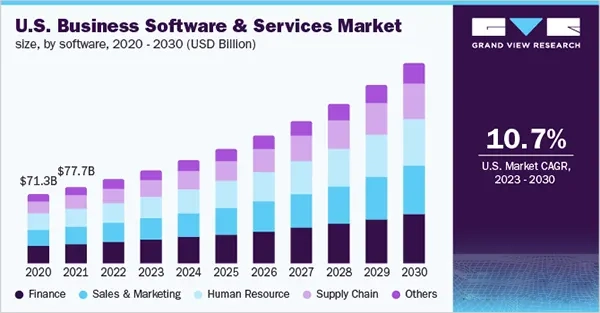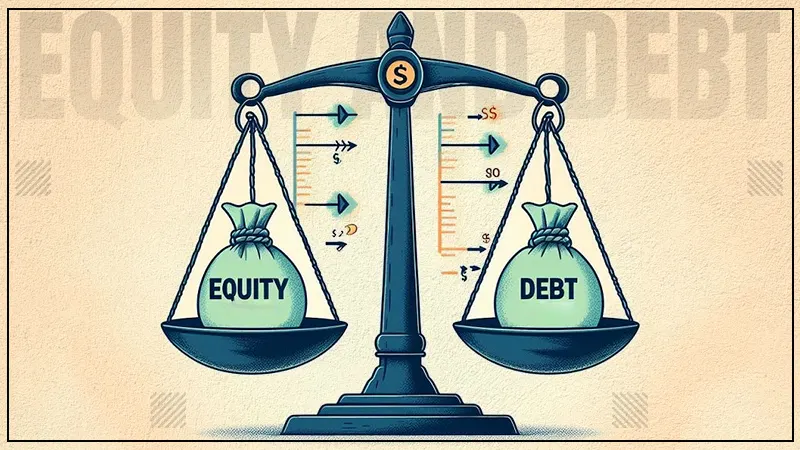The Evolution of Business Software: Trends and Innovations in the Tech Industry

Did you know?
53.6% of software development projects are based on business automation.
Yes! And that’s how businesses have been leveraging it for several striking benefits such as increasing efficiency, data accuracy, scalability, adaptability, better decision-making, and enhanced compliance management.
But what actually is business software and how is it helping businesses grow?
Well in simpler terms, business software is computer programs used by business owners to measure and increase their productivity and to perform business functions more accurately.
Along with that, in an organization business software company works as a glue that ties teams and business processes together! And just like other software, business applications have also undergone several fundamental changes and evolved over time.
So, in this read, I’m going to walk you through the key trends that have shaped the evolution of business software. Along with some modern innovations that are arousing excitement. Also, learn about Small Business Consulting with this guide.
Let’s start!
What are the Elements of Business Software?
Before we dive into the more complex stuff, first we need to understand the elements of business software. So basically any business consists of three major elements, which is:
User Interface (UI): This is a process designers use to easy-to-use and engaging interfaces in the applications.
Business Logic: These are the custom rules and algorithms that regulate informational exchange between database and user interface.
Data: It is the information on which the business logic is based.

The above graph shows the market share of the business software or services and a market forecast from 2020 to 2030
The Evolution of Business Software Model
Take a look at the evolution of the business software model from the point of view of user interface (UI), logic, and data:
Mainframe era: 1950s to 1980s
During the heydays of mainframes and microcomputers, all the logic and data of the business applications resided on the same network with no clear separation. The user interface was limited to the character display terminal, whereas the input was only the keyboard.
Client-server era: 1980s to 1990s
As microcomputers gradually decreased in price and increased in power, organizations transitioned from centralized servers to fat client ones. That resulted in a rich user interface in the business applications with limited separations of the elements on the server side.
Web era: 2000s
The service-oriented architecture gave rise to the 3 tier architecture with a clear separation of user interface, business logic, and data.
Emerging web technologies gave rise to rich internet applications that were mature enough to wrestle with the applications developed for specific microarchitectures.
Mobile era: 2010s
The advent of smartphones, social media, and cloud services has significantly increased the demands of business applications. Where the Internet of Things (IoT) gave rise to the modified 3-tier architecture.
Did You Know?
The worldwide IT Spending on enterprise software is around 913 billion U.S. dollars with a growth rate of 12.4% when compared to the previous year.
Current Trends and Innovations in Business Software Development
The Ever-evolving world of business software development is constantly adapting to the changing needs of customers, markets, or industries.
And in the upcoming years, we are thrilled to see some exciting trends and technologies that are shaping business software and delivering an innovative solution for businesses of all sizes.
Following are some of the trends that are shaping the business software in the upcoming years:
Artificial Intelligence (AI)
AI is one of the most disruptive forces in the tech industry which not only allows developers to create more efficient and intelligent applications but also a more personalised one. It can help in learning from the data, optimize performance, and automate the tasks.
Some of the upcoming AI trends are as follows:
- Natural language processing (NLP),
- Deep learning,
- Machine learning,
- Computer vision,
- Reinforcement learning,
- Generative adversarial networks (GANs),
- And explainable AI
Ai provides several helpful tools to software developers such as testing, debugging, and code generation that help them improve productivity and quality.
Blockchain
Blockchain is a decentralized system with high security and transactional transparency. And not only fintech it can be applied to other business sectors too such as supply chain management, accounting and voting, etc.
For example, Walmart uses blockchain technology to track the origin and quality of its food products.
Web3
As the next generation of the web, Web3 aims to create a more decentralized and user-centric internet. It leverages blockchain, peer-to-peer networks, smart contracts, and cryptography that help businesses in increasing their security and transparency.
Also, it supports virtual reality (VR) and augmented reality (AR) which creates an interactive and immersive experience for the user. For example, a Web3 platform called Decentraland allows you to create and explore virtual worlds.

Cloud Computing
Cloud computing is another significant trend, allowing businesses to store data remotely and cutting tons of maintenance costs associated with hardware storage.
It allows businesses to run applications on edge devices to reduce latency, bandwidth, and cost while providing them with high performance and scalability.
Low-code and No-code Platforms
Low-code and no-code platforms are tools for people who either do not have the time to code or don’t know how to code. such as Excel, Lotus Notes, and Microsoft Access.
It can save time and money on custom applications with only minimal coding experience required. For example, OutSystems is a low-coding platform that allows users to create applications with minimal coding.
Final Thoughts
In closing, the tech industry is undergoing a major transformation and as we look into the future the artificial intelligence and quantum computing is definitely going to be a next big thing in the tech industry.
Hence we can expect to see some more technological advancements in the tech industry that will influence software development. Thanks for reading!






